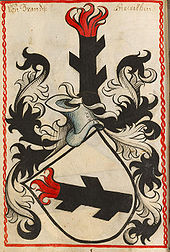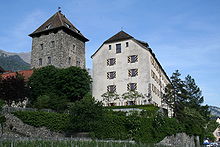Sigmund II of Brandis

Sigmund II von Brandis (* before 1486 ; † November 18, 1507 ) was a member of the Swiss family of the Barons von Brandis . He became known through his arrest and being held hostage together with his brother Ludwig during the Swabian War in 1499. Ludwig was imprisoned in Lucerne , Sigmund in Chur . Together with his siblings, he was ruler of Schellenberg and Vaduz in what is now the Principality of Liechtenstein . He was also ruler of Maienfeld in what is now Graubünden and Blumenegg in Vorarlberg .
family
Sigmund von Brandis was a son of Ulrich von Brandis and his wife Praxedis von Helfenstein and the grandson of Wolfhart V. von Brandis . He had a brother Ludwig von Brandis , with whom he shared the rule of the barons in the Rhine Valley. Four other brothers embarked on a spiritual career. His older brother Ludwig took control of Schellenberg and Vaduz , and he himself took control of Maienfeld and Blumenegg . Sigmund II von Brandis was married to Katharina von Hewen. There were no offspring from the marriage. His youngest brother Johannes von Brandis was the last male descendant of the Lords of Brandis. He later sold the territories to the Counts of Sulz from Rottweil and the Drei Bünde .
Live and act
After the death of his father in 1486, Sigmund and his brother Ludwig took over the joint inheritance. In 1492 and 1496 these enfeoffments of the two brothers were confirmed by the German king. Sigmund II. Was responsible for Maienfeld and Blumenegg after an internal division. He was involved in legal conflicts with the city of Maienfeld.
At the beginning of the Swabian War, the Swiss troops camped in Sargans , the imperial troops in Balzers and the troops of the Drei Bünde in Maienfeld and on the St. Luzisteig - a pass that connected the Austrian Feldkirch with the Bünderischen Maienfeld. The brothers were in a difficult situation. On the one hand, they were obliged to be loyal to the Habsburg emperor and, on the other, to the Old Confederation , since they were citizens of the city of Bern and their ancestors had entered into castle rights with it. By owning the Maienfeld rulership, they were also part of the Three Leagues . On February 6, 1499, troops of Uri captain Heini Wolleb briefly crossed the Rhine and set fire to several houses in Balzers. This is considered to be the beginning of the Swabian or Swiss War. The conflict is said to have been triggered by mutual insults across the Rhine.
The Landsknechte of the Swabian Confederation in the service of the emperor attacked the positions of the Bündner on St. Luzisteig and occupied Maienfeld the following day. But the Bündner did not give up and attacked Maienfeld on the same day. In doing so, they routed the Swabian troops and took the lord of the castle Sigmund II prisoner, who - unlike his brother Ludwig - refused to flee. After Maienfeld was conquered, the Grisons stormed the fortifications of St. Luzisteig and captured Balzers. On February 12, the Confederates encamped near Sargans intervened in the fighting and defeated the imperial Swabian troops in the battle near Triesen . On February 13th, the allied Graubünden and federal troops captured Vaduz and also captured Ludwig von Brandis. In negotiations he offered 20,000 guilders for his release and for the integrity of his county of Vaduz. The allies did not enter into such a deal and took it to Werdenberg on the night of February 13-14 , then via Rapperswil to Lucerne . His brother was imprisoned in Chur . The Swabian and federal troops devastated and plundered the dominions of Vaduz and Schellenberg.
On July 8th, the Diet in Lucerne dealt with the captured men. The situation was difficult because they were also citizens of the city of Bern and as such were under its protection. The daily statute wanted to release them, but Ulrich von Sax , who was in the service of the Confederates, demanded an exchange of Sigmund II von Brandis for Ammann von Appenzell Rudolf von Rappenstein , an ally of Sax, who had been captured by the imperial troops .
After the peace treaty in Basel , the assembly decided the release of the two brothers and their reinstatement in their territories. On December 13th, the subjects in Schellenberg and Vaduz swore allegiance to the Lords of Brandis again. Blumenegg and Maienfeld also became part of the brothers' territory again. At least Sigmund II exercised power over Maienfeld between 1502 and 1504. However, he planned to sell the Maienfeld and Blumenegg rule to the Roman, German King Maximilian , who later became German Emperor. In 1505 he received a deposit of 1100 guilders for this. After the death of his brother Ludwig, he had the power of rule over Vaduz and Schellenberg confirmed by the emperor on August 2, 1507 after the Reichstag in Constance. Due to his death, however, the sale no longer took place. The country was devastated by the fighting and only a few years later (1509–1512) the lordships of Schellenberg, Vaduz and Blumenegg were sold to the Counts of Sulz . Maienfeld was sold to the Drei Bünde in 1510 .
Individual evidence
- ^ Sigmund II., Historical Lexicon of Liechtenstein
- ↑ Claudius Gurt: Rule between fronts; The Lords of Brandis and the Swiss or Swabian War 1499 , Yearbook Volume 114, Historischer Verein für das Fürstentum Liechtenstein (2005), pp. 97–115
- ^ Maienfeld Historical Lexicon of Liechtenstein
| personal data | |
|---|---|
| SURNAME | Brandis, Sigmund II of |
| BRIEF DESCRIPTION | Member of the family of the Barons von Brandis |
| DATE OF BIRTH | before 1486 |
| DATE OF DEATH | November 18, 1507 |
